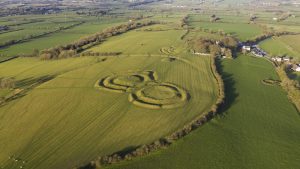Dr Jenny Butler, a well-known folklorist and scholar of religions, is the leading authority on the academic study of contemporary Paganism in the Irish context, having conducted the first ever ethnographic study of Irish contemporary Paganism. As we celebrate Halloween, or Samhain, she describes Irish traditions and background:
Samhain is a festival that marks the traditional start of winter in Ireland, a time associated with the otherworldly and with magic. The spiritual world in Irish tradition is interconnected with the landscape and environment around us. A mythological battle is the reason given for why the victors in the battle, the Milesians, took the surface part of Ireland while the defeated Tuatha Dé Danann agreed to live inside the hills and mounds, inhabiting an underground realm. In folklore, the Tuatha Dé Danann become the aos sí, meaning “people of the mounds”, also translated as “fairies”.

Some of these mounds and “hollow hills” are pre-Celtic, such as the Hill of Tara and Newgrange, two sites in Co. Meath, parts of which date to the Neolithic period. Other mounds, or what are now flattened mounds, are ringforts or “fairy forts”, which date to the Early Medieval period, some dating to much earlier.
Legends tell how these mounds open up at Samhain and allow the inhabitants of the otherworld to mix with humans, and the dead to mingle with the living. Legend has it that an otherworldly inhabitant, the Púca, which can shapeshift into a horse or goat, comes out at Samhain to urinate or spit on bushes and therefore it is unlucky to eat fruit from bushes after Samhain.
Some say that traditions like guising began when people tried to disguise themselves from malevolent spirits abroad at Samhain, while others think it might have been a way of acknowledging the returning dead. Other customs, like leaving the doors of the house unlocked or setting a place at the table for deceased relatives who were understood to return to where they once lived on Samhain night, point to the customs being in honour and remembrance of the dead, possibly deriving from ancient ancestor veneration.
Dr Butler has been working in the area of cultural studies, folklore and religion as a Lecturer in University College Cork for 23 years. She is fascinated by the otherworldly and magical aspects of life, spiritual connection to the world, rituals, festivals, and sacred landscapes.
She was awarded a Government of Ireland Postgraduate Scholarship to conduct her doctoral research on contemporary Paganism in Ireland. The scholarship enabled her conduct her research, which involved fieldwork where she interviewed druids and witches, accompanying them on visits to sites on the landscape which are special to them.
Funding this kind of work through bodies such as Research Ireland is important for Ireland’s cultural heritage, supporting researchers in documenting our great variety of traditions and to gain insights into how people live in the modern day, on what holds meaning, and what connects people to the past.
“Being awarded Research Ireland funding at any stage is prestigious and helps researchers raise their profile and it bolsters their career. I know that being a Government of Ireland researcher has helped me in my career and opened many doors for me”.
Learn more about Dr Butler’s work: https://www.youtube.com/watch?v=__g8P43_uXg
